with switched power supply and a stereo setup
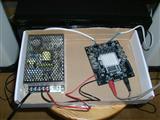
|
An excellent "ready to run" Class-D amplifier (2 x 50 W rms)
with switched power supply and a stereo setup |
 |
Back to Stefan's Some technical projects page
Report by Stefan Spännare, June 2009
Note, print this web-page in landscape mode if it doesn't fit into portrait A4.
i. Warning
1. Introduction
2. What is an ideal amplifier?
3. Some thoughts about home stereo systems
4. Stereo system setup
5. Data for the Sure Electronics Class-D stereo amplifier and the power supply
6. Advantages and disadvantages with the Sure Electronics Class-D stereo amplifier
7. Building hints
8. Components and prices
9. Some images (photos) of the stereo setup
Updated!
10. How to repair the damaged Chorus Delta speaker
11. References
The author makes no warranties that this document is free of errors.
See also important "Building hints" in section 7 below.
i. Warning
Interested in different kind of amplifiers and audio systems (to reasonable
prices) I found and bought (in June 2009) a new interesting Class-D amplifier
(2 x 50 W rms) in an advertisement at Blocket in Sweden. It is manufactured
by Sure Electronics and sold by Dyds Electronic in Sweden (see the references).
The amplifier turns out to be very good and has fine data.
I also come across some very good Chorus Delta speakers, (2 x 50 W, "made
in Sweden" with concrete boxes), bought second hand to a very reasonable
price. Actually one of the speakers was damaged, but I managed to mend it
(see section 10). The DVD/CD-player from LG is also very good and bought
second hand.
Here is a short description of this stereo audio system, some technical
information about it and my (subjective) experiences and thoughts of
using and listen to it.
I have actually not seen a definition of an ideal amplifier, but something
like this could fit:
An ideal amplifier is completely linear over the whole observed frequency
range without adding noise or distortion to the signal.
This statement is also valid for a complete stereo or electronic music system
including speakers, CD player etc.
Of course such an "ideal music system" does not exist, but it is possible
to come close.
This text is now moved to a separate web-page found here.
The new stereo system consists of the following components:
IC: TP 2050 with heatsink (thermal warning at 130 °C, shut down at 150 °C)
100 W music power (50 W rms) at 4 Ohm load per channel
50 W music power (25 W rms) at 8 Ohm load per channel
Distortion: 0.01 % THD+N at 75 W, 4 Ohm
Distortion: 0.01 % THD+N at 35 W, 8 Ohm
Class-D type (i.e. PWM-switched)
Efficiency: 85 - 90 %
Signal to noise ratio: 80 dBA
Channel separation: 95 dB
Input impedance: 22 - 47 kOhm
Sensitivity: adjustable with DIP-switches on the PCB
Power supply: 10 - 36 V (≥ 60 W, 27 V DC stabilized recommended)
PCB dimensions: 95 x 115 x 20 mm (with components and heatsink)
Weight: ≈ 100 g (with components and heatsink)
Type: Switched and stabilized operation
Voltage: 22 - 27 V adjustable with trim potentiometer (27 V recommended here)
Maximum power: 60 W (2.22 A at 27 V)
Mains voltage: 230 V AC (fuse 0.5 A slow)
Dimensions: 100 x 155 x 40 mm
Weight: ≈ 700 g
The Sure Electronics Class-D amplifier and the switched power supply comes
almost as a "ready to run" kit. Some cables must be connected, volume
potentiometer added and the whole thing must be mounted in a box. The box
can without problems be of plastic type and must have holes on the upper
panel for air and heat circulation. Female chassis banana contacts for the
speakers and RCA-cable for the audio signal come with the amplifier.
The cables are easy to connect. But be very careful to check correct polarity
for the power supply and speaker cables. The power supply voltage was adjusted
to 27 V (maximum). This relatively small power supply can only give 2 x 30 W
rms to the amplifier, but this is more than good enough for home usage. But to
act as a small "current reservoir" at high transients I connected an electrolytic
capacitor of 3300 uF, 50 V (and a discharge resistor of 1 kOhm, 2 W) directly
to the power supply cable connectors on the amplifier board. I don't know if it
helps, but it should at least do no harm.
Even more important is to connect the mains voltage cable correctly. Something
wrong here could be dangerous. It is also recommended to have a fuse (0.5 A
slow) to the power supply.
The gain on the amplifier was adjusted to maximum (i.e. all four DIP-switches on).
This works fine also with a DVD/CD-player.
A 50 kOhm stereo volume potentiometer was used here (because I had one at hand)
but perhaps a 10 kOhm potentiometer could reduce possible noise somewhat. But
that is not at all a problem with this amplifier.
The total price for the Sure Electronics Class-D amplifier (including power supply
and volume potentiometer) is about 1130 SEK or $ 140. The prices below are given
in SEK (June 2009) including VAT (25 %) and delivery costs. These electronics
shops are found in Sweden. Audio cables and female banana contacts (for the
speakers) come with the amplifier. Price for a box comes extra. Plastic boxes
are not so expensive.
| Nr | Component | Company | Article nr | Price per item (SEK) | Price (SEK) |
| 1 | Sure Electronics Class-D amplifier (2 x 50 W rms) [1] | Dyds Electronic | ? | 695.00 | 695.00 |
| 1 | Switched power supply (22 - 27 V, 60 W) | Dyds Electronic | ? | 295.00 | 295.00 |
| 1 | Volume potentiometer stereo 50 k log | ELFA | 64-145-28 | 140.00 | 140.00 |
| Price total (SEK): | 1130.00 |
[1] The article number for the amplifier at Sure Electronics is AA-AB014. Dyds Electronic sell them in Sweden.
1. Overview of the stereo setup. The Chorus Delta speakers (in white painted
concrete) the LG DVD/CD-player with volume potentiometer and RCA-switch
boxes on top and the very temporary paper box with the Sure Electronics
Class-D amplifier and the switched power supply on the small stool. Some other
audio equipment and my Dali 7 A speakers (connected to another amplifier)
are seen at the edges of the image. The small black device with "antenna" on
the floor close to the right speaker is my AGK Nordic wireless audio link
(2.4 GHz) between my main computer and this stereo.
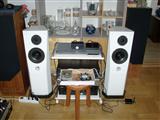
2. Another overview of the stereo setup.
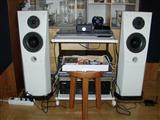
3. A close up of the speaker elements in one of the Chorus Delta speakers.
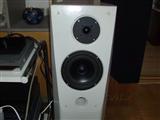
4.1 The Sure Electronics Class-D amplifier (2 x 50 W rms) and the switched
power supply (27 V, 60 W) in a very temporary paper box.

4.2 The Sure Electronics Class-D amplifier (2 x 50 W rms) and the switched
power supply (27 V, 60 W) in a very temporary paper box. Here the 3300 uF, 50 V
capacitor and the 1 kOhm, 2 W resistor (mentioned in section 7) are also seen.
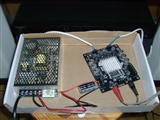
5.1 The amplifier and power supply again.
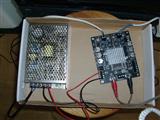
5.2 The amplifier and power supply again, here with the capacitor and resistor.
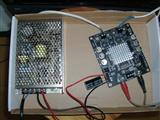
6. The LG DVD/CD-player with volume potentiometer and RCA-switch boxes on top.
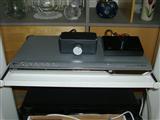
7. The volume potentiometer and RCA-switch boxes seen from above.
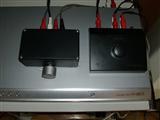
Somewhat supplementary, but when I got the Chorus Delta speakers one of
them was damaged and had the two coils in the crossover filter unwinded for
some strange reason. The filters are very conveniently located free and visible
under the "foot" of each speaker. To repair it I measured the dimensions and
revs of the coils on the functioning speaker. After quite a time of search with
Google I found the very nice "Coil Inductance Calculator" web-page (see the
references) and then used it to calculate the values of the coils (in mH). The
calculated values (0.200 actually and 0.417 mH) fitted surprisingly well to
standard coil values (0.20 and 0.40 mH). New coils were ordered from Ljudia
in Sweden (see the references). Then it was only to cut off the copper wires
from the old unwinded coils and solder in the new ones. There were precise
space for them. The diameter of the insulated copper wires in the old coils
was 0.7 mm and 0.8 mm in the new ones (that doesn't affect the inductance).
The mended speaker works very well and sounds exactly as the other one.
Amplifier user's guide (to download):
Some useful Internet links: